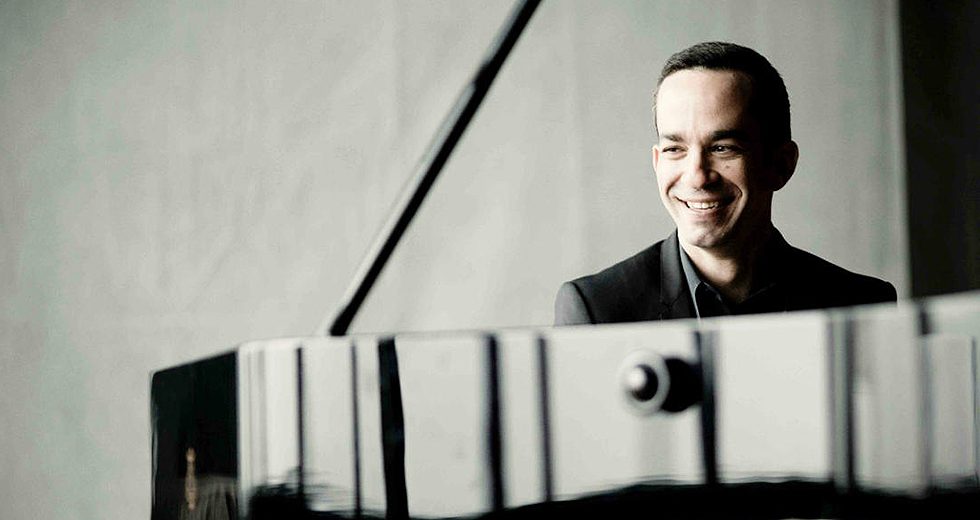
When the New York Philharmonic chose Inon Barnatan as its first artist-in-association, the appointment was and was not a surprise. The Israeli-born pianist had never previously performed with the N.Y. Phil, but the orchestra knew what it was getting. Since moving to New York City in 2006, he has become a regular and welcome presence on the city’s classical scene; the emotional and intellectual depth of his playing, combined with his easy-going, articulate manner, made him an ideal candidate.
The position’s unusual name was meant to differentiate it from the orchestra’s annual artist-in-residency, a post that has been held in 2016-17 by violinist Leonidas Kavakos. In this longer-running role, starting in 2014-15 and ending this season, Barnatan has appeared as a concerto soloist during at least one set of subscription concerts, participated in chamber-music performances with N.Y. Phil musicians and served as a general ambassador for the orchestra. “It’s being part of the family for three years, which was incredible,” he said. “It was such a fantastic experience in every way.”
Barnatan will make a debut with another major American orchestra when he joins guest conductor Jesús López-Cobos and the Chicago Symphony Orchestra during concerts May 25, 27 and 30. “I’m incredibly excited about that,” the pianist said. “It’s always been a dream of mine to play with the Chicago Symphony. It’s certainly one of the most significant debuts this season, for sure.”
For his CSO debut, the artistic staff asked him to serve as soloist in George Gershwin’s well-known Concerto in F. He said he feels affection for the piece, which he has performed with the Philadelphia Orchestra, among other ensembles. Sometimes the concerto is treated as a jazz or classical piece, he said, but it needs the fusion of the two to work successfully. “It’s so much fun for me to explore that,” he said, “because I’m a big jazz fan.”
Jazz pianist Aaron Diehl, a good friend to Barnatan, performed the Concerto in F during the New York Philharmonic’s season-opening concert in September. The two got together and played through the concerto and had a kind of “cultural exchange,” each sharing their perspectives on the piece from their respective backgrounds in the jazz and classical worlds. “I feel that Gershwin writes so well,” Barnatan said. “It’s earned its popularity, for sure.”
Too often, Barnatan said, the Concerto in F is only heard at summer festivals or on all-American programs. But he believes it deserves to be presented on regular subscription programs like any other piano concerto, and he is pleased that the Chicago Symphony is doing that. The work has been grouped with Spanish composer Joaquin Turina’s Danzas fantásticas and Antonín Dvořák’s Symphony No. 6.

Inon Barnatan and Alan Gilbert are recording a Beethoven project with the Academy of St. Martin in the Fields.
One of the most important byproducts of Barnatan’s time with the New York Philharmonic has been the close association he has developed with departing music director Alan Gilbert. The two appeared together Oct. 20-22 with the Leipzig Gewandhaus Orchestra in Germany and April 22-23 with the Tokyo Metropolitan Orchestra in Japan.
In addition, Barnatan and Gilbert are joining the London-based Academy of St. Martin in the Fields in recording all of Ludwig van Beethoven’s concertos that incorporate piano, including the composer’s ground-breaking Concerto for Violin, Cello and Piano in C Major, Op. 56. Barnatan describes Gilbert as a “musical adventurer” and admires the conductor’s focus and passion. “It’s really been such an incredible musical partnership and friendship,” he said. “We both have similar ways of looking at things and enjoy hanging out as well.”
Barnatan, 38, has built a significant relationship with the Academy of St. Martin in the Fields, with which most recently he undertook a 12-city American tour that ran from March 18 through April 2. Thanks to his “voracious appetite” for repertoire, each program included two of three very different keyboard works: Mozart’s Piano Concerto No. 9 (Jeunehomme), Shostakovich’s Piano Concerto No. 1, and Alasdair Nicolson’s newly commissioned Piano Concerto No. 2, “The Haunted Ebb.” Although he was billed as both pianist and conductor for the tour, something he has done previously with this ensemble, Barnatan downplayed the latter role. While he does offer some cues from the keyboard, it’s more of a “direct communication” that comes from playing side by side. “I’m not a conductor and I don’t pretend to be,” he said. “But I enjoy making music with them and have it be a kind of chamber-music experience. I’m as much leading as I am following in that respect. It’s a very gratifying way of making music.”
When Barnatan decided he wanted to record the Beethoven concertos, he approached the Academy of St. Martin in the Fields. “I felt there is no other orchestra I would rather explore this with,” he said. The ensemble was receptive to the idea, especially after discovering it hadn’t done such a project before. “They were surprised to find out that it was their first recorded cycle, because they have been playing it for so many years,” he said.
Gilbert agreed to serve as conductor for the undertaking, making his debut with the ensemble, and the results have far exceeded Barnatan’s expectations. “The chemistry was just electric,” he said. He hopes to finish the recording process this year, with the concerto set being released in another year or two.